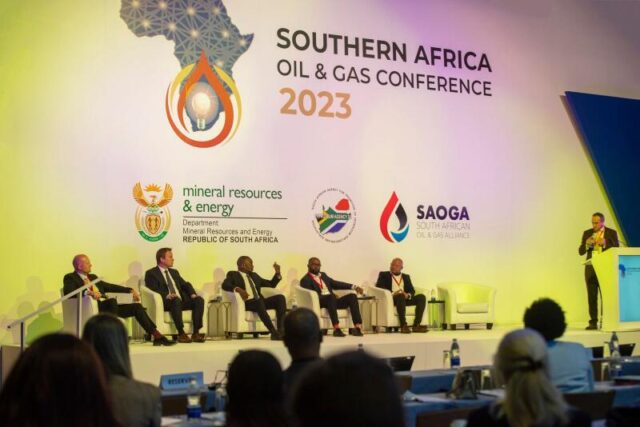“Mozambique is up and running, Namibia is up and running, South Africa wake up!”
SOUTH Africa needed a “war room” to boost its oil and gas developments and to better coordinate government departments on these projects, Deputy Minister in the Presidency for Planning, Monitoring and Evaluation Pinky Kekana said on Thursday.
She said in an address to the Southern Africa Oil & Gas Conference 2023 that, “Mozambique is up and running, Namibia is up and running, South Africa wake up!”
She said that the Petroleum Agency for South Africa (PASA) estimated South Africa potentially held 27 billion barrels of oil and 60 trillion cubic metres gas offshore, let alone the onshore resources, but development in the sector remains weak due to a number of factors including weak infrastructure, insufficient investment and technological issues.
She said the “war room” should comprise all the relevant government departments, so that “there is one centre” for these developments, promoting “one message”, and various government departments did not pull investors in different directions, she said.
Adrian Strydom, the CEO at the South African Oil and Gas Alliance, said the growth of the sector had “game-changing potential for the region and we cannot afford to ignore this.
“The load shedding we are experiencing was an indication of the need to allow for all the energy technologies and resources to be explored,” he said.
Dr Bongani Sayidini, the chief operating officer at PASA, said South Africa had sufficient gas resources to realise the aims of its gas sector policies. Internationally, gas utilisation as a primary source of energy in developed countries had averaged 24%, but in South Africa this figure was less than 3%.
A government integrated resource development plan had stated a target to increase this to 16% by 2030.
What little existing regional gas supply there was to the country, to Sasol via the Pande Temane fields in Mozambique, was expected to decrease sharply from 2026 as the reserves were depleted – an event Sasol had already notified its many industrial off-take partners of.
Dr Sayidini said apart from the estimated 60 trillion cubic feet of gas (tcf) offshore of South Africa, there were also some 200tcf of gas onshore.
“We do have the gas,” he said, citing production estimates from the West, Southern and Eastern coast offshore exploration areas.
He said the Ibuhesi gas find on the West Coast operated by Sunbird Energy, which was discovered many years ago, had become a “stranded asset” as the project developers could not find a close and big enough market to justify developing the field.
A similar situation had arisen with Namibia’s Kudu Gas Fields, but “given where we are at with the Just Energy Transition”, moves were afoot to monetise the fields.
On the south coast, regulatory approvals was still underway for the significant Brulpadda and Luiperd gas discoveries operated by TotalEnergies in the 11B and 12B offshore blocks. Along the east coast, seismic surveys were suspended by court action by stakeholders.
He said in Mpumalanga, on land close to the existing gas infrastructure near Secunda and many electrical power stations, the Kinektico Energy Company had discovered significant liquid natural gas (LNG) resources that might be able to mitigate the potential negative impacts of gas depletion to Sasol.
Nick de Blocq, the CEO at Kinektico Energy, said they had spudded 41 wells over 12 years and each had been successful, with a 42nd well currently being spudded.
He said this “100% strike rate” rate was unheard of in the gas industry, and in addition, the quality of the gas was exceptional, comprising up to 98% methane, while the rest was nitrogen. There was also no need to frack or do horizontal drilling.
The gas would also maybe find a market at the nearby coal mines, which were having to burn large quantities of diesel due to load shedding.
He said they had registered the gas project with the President’s Special Infrastructure Project (SIP) Commission, in the hope that it would help to expedite the regulatory guidelines and other processes when it came to develop the project further.
Thabang Audat, the chief director at the Department of Mineral and Energy Resources, who worked with the team responsible for the draft Gas Master Plan 2023, said they were advocating for a future mix of energy sources, not just gas, but that a clear policy on the development of the gas industry was required.
A middle-case scenario was for gas to be phased in as feedstock, to replace coal, for Eskom’s power stations, as they were decommissioned during the next few years to 2035.
He said LNG might need to be imported by ships in the future to account for the declining gas from the Pande Temane gas field in Mozambique, which would require the flow of the gas pipeline from Richards Bay to Secunda to be reversed.
He said South Africa was in an energy crisis, and the various rounds of renewable energy projects had not yet been enough to alleviate this crisis. LNG, which was a cleaner source of energy than coal, “is necessary to complement renewable energy”.
BUSINESS REPORT








